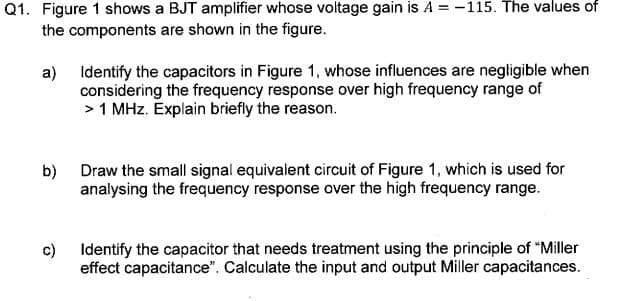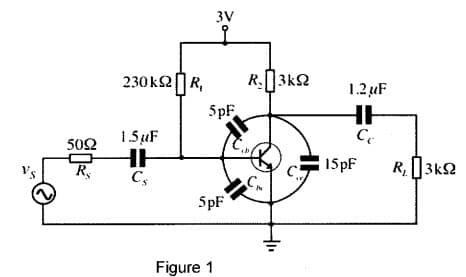The values of Q1. Figure 1 shows a BJT amplifier whose voltage gain the components are shown in the figure. a) Identify the capacitors in Figure 1, whose influences are negligible when considering the frequency response over high frequency range of > 1 MHz. Explain briefly the reason. b) Draw the small signal equivalent circuit of Figure 1, which is used for analysing the frequency response over the high frequency range. c) Identify the capacitor that needs treatment using the principle of "Miller effect capacitance". Calculate the input and output Miller capacitances.
The values of Q1. Figure 1 shows a BJT amplifier whose voltage gain the components are shown in the figure. a) Identify the capacitors in Figure 1, whose influences are negligible when considering the frequency response over high frequency range of > 1 MHz. Explain briefly the reason. b) Draw the small signal equivalent circuit of Figure 1, which is used for analysing the frequency response over the high frequency range. c) Identify the capacitor that needs treatment using the principle of "Miller effect capacitance". Calculate the input and output Miller capacitances.
Introductory Circuit Analysis (13th Edition)
13th Edition
ISBN:9780133923605
Author:Robert L. Boylestad
Publisher:Robert L. Boylestad
Chapter1: Introduction
Section: Chapter Questions
Problem 1P: Visit your local library (at school or home) and describe the extent to which it provides literature...
Related questions
Question

Transcribed Image Text:Q1. Figure 1 shows a BJT amplifier whose voltage gain is A = -115. The values of
the components are shown in the figure.
a)
Identify the capacitors in Figure 1, whose influences are negligible when
considering the frequency response over high frequency range of
> 1 MHz. Explain briefly the reason.
b)
Draw the small signal equivalent circuit of Figure 1, which is used for
analysing the frequency response over the high frequency range.
c)
Identify the capacitor that needs treatment using the principle of "Miller
effect capacitance". Calculate the input and output Miller capacitances.

Transcribed Image Text:5092
R
230kΩ || R,
1.5 μF
HH
Cs
3V
5pF
5pF
Figure 1
R. 3kQ2
1.2 μF
HH
Cc
C 15pF
R₂3kQ2
Expert Solution
This question has been solved!
Explore an expertly crafted, step-by-step solution for a thorough understanding of key concepts.
Step by step
Solved in 2 steps with 1 images

Follow-up Questions
Read through expert solutions to related follow-up questions below.
Knowledge Booster
Learn more about
Need a deep-dive on the concept behind this application? Look no further. Learn more about this topic, electrical-engineering and related others by exploring similar questions and additional content below.Recommended textbooks for you

Introductory Circuit Analysis (13th Edition)
Electrical Engineering
ISBN:
9780133923605
Author:
Robert L. Boylestad
Publisher:
PEARSON

Delmar's Standard Textbook Of Electricity
Electrical Engineering
ISBN:
9781337900348
Author:
Stephen L. Herman
Publisher:
Cengage Learning

Programmable Logic Controllers
Electrical Engineering
ISBN:
9780073373843
Author:
Frank D. Petruzella
Publisher:
McGraw-Hill Education

Introductory Circuit Analysis (13th Edition)
Electrical Engineering
ISBN:
9780133923605
Author:
Robert L. Boylestad
Publisher:
PEARSON

Delmar's Standard Textbook Of Electricity
Electrical Engineering
ISBN:
9781337900348
Author:
Stephen L. Herman
Publisher:
Cengage Learning

Programmable Logic Controllers
Electrical Engineering
ISBN:
9780073373843
Author:
Frank D. Petruzella
Publisher:
McGraw-Hill Education

Fundamentals of Electric Circuits
Electrical Engineering
ISBN:
9780078028229
Author:
Charles K Alexander, Matthew Sadiku
Publisher:
McGraw-Hill Education

Electric Circuits. (11th Edition)
Electrical Engineering
ISBN:
9780134746968
Author:
James W. Nilsson, Susan Riedel
Publisher:
PEARSON

Engineering Electromagnetics
Electrical Engineering
ISBN:
9780078028151
Author:
Hayt, William H. (william Hart), Jr, BUCK, John A.
Publisher:
Mcgraw-hill Education,